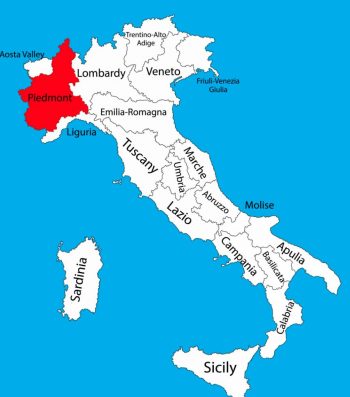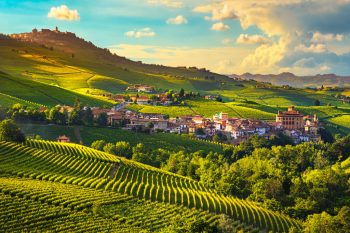Those of you paying attention may remember I mentioned Rob had picked a small parcel of fruit this vintage from Kim Anderson’s Charleston vineyard of a variety we don’t normally see amongst our range.
While we’re not exactly sure what will come of it just yet, I thought that it might be interesting to take a closer look at this variety. I wasn’t massively familiar with it. So, this was as much of a learning experience for me as it will be for you!
The variety is…
Nebbiolo
Nebbiolo (“Nebby-oh-low”) is a full-bodied red wine. It’s probably better known by the names of the two production regions of Barolo and Barbaresco in Piedmont, Italy.
For the visual learners, Piedmont is here…

And looks like this…

Nebbiolo wines are translucent (like Pinot!) and have a delicate floral and light red fruit aromas. It gives the initial impression that the wine is much lighter than it actually is.
You see, when you have a sip you will experience leathery, gripping robust tannin (depending on the style) and high acidity. However, the wine’s fruity flavours of cherry and raspberries, along with aromas of rose and anise, always seem to shine through. In cooler climates/years, Nebbiolo gets a bit herbaceous with more sour cranberry fruit, rose hip and leather and red clay minerality.
As I was doing some research I found this quote…
“Nebbiolo is a thinking person’s wine: subtle yet bold, simple yet complex”
Perfect for a Somerled audience, I’d say!
Nebbiolo Wine Facts
- Nebbiolo is an old, old grape, first being referenced as far back as the 13th Century!
- The name Nebbiolo derives from nebbia, the Italian word for “fog.” This is likely from the white, powder-like natural bloom on the grapes that appears during harvest season. Or, from the fact that the best Nebbiolo sites are located above the fog that collects in the valley.
- Even though Nebbiolo only makes up ~8% of all the grapes grown in Piedmont, more of this grape is grown there than anywhere else in the world.
- Despite being an essential part of two of the country’s premier wines (Barolo and Barbaresco), Nebbiolo is rarely grown anywhere else in Italy.
- Much like Pinot Noir, Nebbiolo is an incredibly fussy variety to grow. It flowers early, ripens late, and can struggle to ripen fully. It also seems to prefer specific hillside locations and clay- and silt-based soils.
- Also like Pinot Noir, Nebbiolo is considered to be a “terroir-expressive” variety. That means that it picks up more of the earth, soil, and climate characteristics than other grapes. Therefore, it can taste wildly different depending on where it’s grown.
Food Pairing
With such a large amount of tannin, you’ll want to pair these wines with foods that feature fat, butter, and olive oil, and nothing too lean (no I’ve got your attention!!). If, like me, you’re thinking rustic, Italian fare, and that’s a fabulous place to start!
Nebbiolo also goes surprisingly well with savoury Chinese dishes and spice-driven Asian cuisine.
Interesting facts!
- Curious why Nebbiolo wines look so light, despite being so massive and tannic? Believe it or not, young Nebbiolo wines do have some rich colour! It just fades really quickly.
- The waiting game used to be the hardest part with top Nebbiolo wines (with some people saying they needed to be aged for a decade or more!). But, new styles of winemaking have made them softer and more approachable when they’re young. These days winemaking techniques such as extended maceration are used to soften tannins.
- During the 1800s Barolo was a sweet wine. (Gasp!) This is likely due to the fact that Nebbiolo is harvested late in the season and colder temperatures halted the fermentation.
- Though Nebbiolo is definitely Piedmont’s grape today, where it originally comes from is a little more unclear. Some say it’s Piedmont, while others think it may actually come from Lombardy in the alpine foothills close to Lake Como.
Nebbiolo around the world
Although its reputation as a grape capable of making some of the world’s finest wines, nebbiolo has not been as widely planted as you might think.
This probably has a bit to do with Italian wines and varieties, not having the same stature as French ones until late in the 20th century.
But also, nebbiolo is not the most adaptable of grapes. As I’ve mentioned, it excels in certain conditions but struggles in most others.
The USA and Australia have dominated plantings of nebbiolo outside of Italy. Bot, though, are still in the relatively early phases of exploring the regions with best potential.
Nebbiolo in Australia
While the plantings number not a lot over 200 hectares, nebbiolo has found suitable homes in areas such as the Adelaide Hills, Victoria’s King, Yarra and Alpine Valleys, Beechworth, the Pyrenees and even Heathcote, with all having produced notable examples.
And while Rob is still working on ours, I don’t think it hurts to point you in the direction of some notable producers – especially now I’ve whetted your apetitie!
Victoria’s Malakoff vineyard in the Pyrenees has become a major source of grapes for younger makers, while the Longview vineyard has served a similar function in the Adelaide Hills. If I were you, I’d take a look at Luke Lambert, S.C. Pannell, Domenica and Traviarti. They’re all making seriously savoury wines that are Barolo-like in their stature. While others such as Spider Bill and Architects of Wine are emphasising the bright red fruit to turn out fresher, yet no less complex versions.
And I tell you all of this, ONLY if you promise to try Rob’s once it’s done!
Promise??
